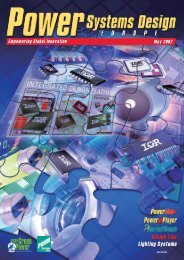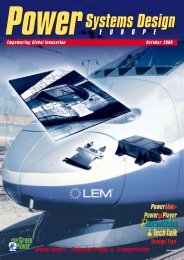Testing Virtual ECUs - Power Systems Design
Testing Virtual ECUs - Power Systems Design
Testing Virtual ECUs - Power Systems Design
You also want an ePaper? Increase the reach of your titles
YUMPU automatically turns print PDFs into web optimized ePapers that Google loves.
© National Semiconductor Corporation, 2011. National Semiconductor, , <strong>Power</strong>Wise, and WEBENCH are registered trademarks. All rights reserved. Complex<br />
LED<br />
<strong>Systems</strong>.<br />
Easy <strong>Design</strong>.<br />
<strong>Design</strong> Tool Creates Optimized Lighting <strong>Systems</strong><br />
in Minutes<br />
National Semiconductor’s WEBENCH ® LED Architect<br />
tool addresses temperature and current variation<br />
affecting light output and LED lifetime by helping<br />
determine the optimal design for your desired lumen<br />
output. Specify, review real-time tradeoffs, generate<br />
your prototype, and evaluate it – all in minutes.<br />
q<br />
national.com/LED<br />
than NiMH, Li-ion batteries require significantly<br />
more battery management (temperature<br />
monitoring, cell balancing, etc.) which increases<br />
the semiconductor content. IMS Research<br />
estimates that the semiconductor content of a<br />
LI-ion battery is currently five times that of an<br />
equivalent NiMH battery, with the majority of<br />
the difference coming from the number of ASSPs<br />
needed for cell pack voltage monitoring.<br />
Automotive OEMs have considerable intellectual<br />
property tied up in the design of their internal<br />
combustion engines. The same is true for<br />
hybrid and electric vehicles on the market at<br />
the moment, with the theory being that electric<br />
motor control is one way of keeping expertise inhouse.<br />
But is this really the ideal way of getting<br />
the most out of an electric vehicle?<br />
Much of the expertise needed to control high<br />
speed electric motors can be found in the<br />
industrial automation or motor industry. Players<br />
in these markets are setting their sights on the<br />
electric vehicle market, particularly with ‘offthe-shelf’<br />
inverter modules. Not only do these<br />
‘modules’ play to their strengths, but they give<br />
vehicle OEMs the opportunity to reduce R&D<br />
costs by outsourcing motor control design.<br />
The automotive OEMs have a big decision to<br />
make: do they go it alone on motor control<br />
design to retain the “engine IP”, or do they work<br />
with existing experts to take advantage of their<br />
experience?<br />
www.imsresearch.com<br />
DESIGNtips<br />
POWER SYSTEMS DESIGN JULY/AUGUST 2011<br />
POWER SUPPLY DEVELOPMENT<br />
DIARY PART XIV<br />
By Dr. Ray Ridley<br />
This article continues the series in which Dr.<br />
Ridley documents the processes involved in<br />
taking a power supply from the initial design to<br />
the full-power prototype. The second layout of the PC board<br />
incorporates significant changes in the power stage, changing<br />
the number of outputs from three to five. Some of the issues<br />
involved in the coupled-inductor magnetics design are<br />
discussed.<br />
T<br />
hree Output Coupled-<br />
Inductor <strong>Design</strong><br />
The original<br />
specification for the<br />
power supply design was as<br />
follows:<br />
1. Output 1 – 35 VDC @ 10A<br />
isolated<br />
2. Output 2 – 35 VDC @ 10 A<br />
isolated<br />
3. Output 3 – 15 VDC Bias<br />
power and regulated output,<br />
primary referenced<br />
4. Maximum power 350 W (only<br />
one output fully loaded at<br />
a time, application is for<br />
audio.)<br />
5. Input – 180 – 265 AC<br />
6. <strong>Power</strong> Topology: Two-switch<br />
forward<br />
Figure 1 shows the schematic<br />
of the three-output forward<br />
Figure 1: Forward Converter with Three Coupled-Inductor Outputs<br />
converter. A single core inductor<br />
is used with three windings,<br />
one for each of the outputs.<br />
This coupled-inductor approach<br />
provides the best cross-regulation<br />
between each of the outputs.<br />
There are two major advantages<br />
of coupled inductors – firstly, all<br />
of the outputs are tied together<br />
through the transformer action<br />
of the inductor, preventing them<br />
from having individual resonant<br />
frequencies. Secondly, regardless<br />
of individual loading on each<br />
of the outputs, the coupled<br />
inductor forces all of the outputs<br />
WWW.POWERSYSTEMSDESIGN.COM<br />
11









